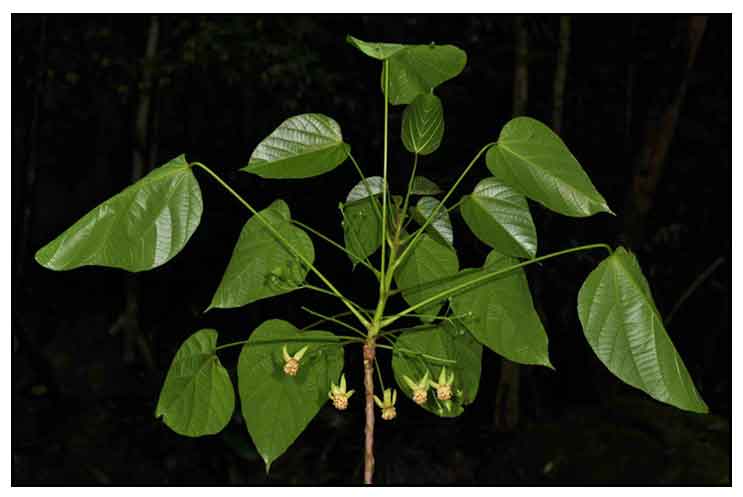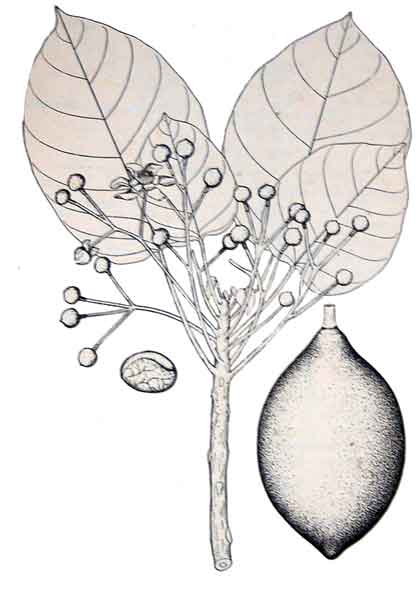 Gen info Gen info
Buah keluak in Malay and Indonesia means "the fruit which nauseates."
Botany
Pañgi is a large, widely spreading tree reaching a height of 25 meters. Leaves are very large, smooth, leathery, broadly ovate or rounded, about 20 centimeters long, with pointed tip and heart-shaped base. Petioles are as long as the leaves. Flowers are yellowish-green or whitish, having a faint odor, about 4 centimeters across. Fruit is pendant upon thick, brown stalks, ovoidly rounded, 10 to 20 centimeters in diameter, brown and rough, containing seeds which are 3 to 5 centimeters across, compressed, somewhat angular, embedded in a yellowish, sweet, aromatic and edible pulp.
 Distribution Distribution
- In primary forests at low and medium altitudes in Camarines and Sorsogon Provinces in Luzon, and in Palawan, Samar, Leyte, Panay, Negros and Mindanao.
- Also occurs in the Malay Peninsula and Archipelago.
Constituents
- Leaves yield a cyanogenetic glycoside, gynocardine, identical to that found in Gynocardia odorata.
- An emulsion-like enzyme, gynocardase, has been identified with the glucoside.
- Kernel oil yields palmitic and oleic acids, and an optically active oil, either hydnocarpic or chaulmoogric, or both.
- Study of picung kernel oil yielded30.26±0.06% water, 8.37±0.05% protein, 8.91±0.08% fat, 36.88±0.08% crude fiber, and 14.50 ±0.10% carbohydrate. (11)
- Study for fatty acids yielded lauric, myristic, myristoleic, palmitic, palmitoleic, stearic, oleic, linoleic, linolenic, arachidic, erucic, and lignoceric acids. Linoleic and oleic acids are major fatty acids accounting for 40.79±0.76% and 38.31±1.28%, respectively.
(11)
- Roots and fruits yield alkaloids, flavonoids, steroids, and triterpenes. (15)
Properties
- Kernel is considered poisonous.
- Plant considered anthelmintic
- Seeds, fruit, leaves and bark possess narcotic properties, in excessive amounts may cause sleepiness, headache, intoxication, delirium or even death.
- Studies have suggested antibacterial, antifungal, antioxidant, molluscicidal, anti-HIV, wound healing, MAO inhibitory properties.
Toxicity
- Most medicinal and poisonous applications of P. edule are due to the presence of hydrocyanic acid in all parts of the plant (seeds, fruits, bark, and roots). (13)
-
Various ways are reported to leach buah keluak of poison. Fruit is left to ripen until the flesh falls off and the seeds are then removed. Seeds are crushed, boiled, and put on running water for a day. After a second boiling, they are reported ready for consumption. (10)
-
A method of reducing hydrocyanic acid toxicity is by the fermentation method: boiled seeds are buried with ash in a pit, the seeds slowly fermenting over 40 days, reducing toxicity. (10)
- The poisonous component can be deactivated by extensive washing, soaking, roasting, or fermenting. (13)
- Ingestion of improperly prepared or unripe seeds can cause vomiting, abdominal swelling, contraction of the tongue, and death. (10)
Parts used
Seeds, leaves.
Uses
Edibility / Caution
- Pulp surrounding the seed is eaten in some parts of the Philippines. However, there are reports that it causes headaches.
- Although the kernel is considered poisonous, it is rendered edible by steeping or roasting.
- In Java, the oil is edible after prolonged boiling.
- In Kosrae, although considered poisonous, carefully washed and cooked older leaves, fruits, and seeds can be eaten. (3)
- Leaves reportedly used as food in North Sulawesi. (18)
- In Singapore and Malaysia, seeds are essential ingredient in ayam (chicken) or babi (pork) buah keluak, a mainstay of Peranakan cuisine.
(22)
Folkloric
- In the Philippines, all parts of the plant are considered anthelmintic.
- Seeds, fruits, leaves, and bark considered narcotic, and in excessive doses causes sleepiness, headache, intoxication, delirium, and occasionally fatal
-
Freshly crushed seeds applied by Malays to boils.
- Leaves have anthelmintic action.
- Fresh leaves, leaf sap, pounded leaves or ground fresh seeds are externally applied as antiseptic or disinfectant to cleanse ulcerations, infested wounds, and to treat scurf. Used as insecticide against head lice and ticks or as insect repellent.(13)
- In Papua New Guinea, juice from sliced fruit applied to sores and cuts. (13) Fluid from moist scraped bark is applied to tropical ulcers.
(16)
- In North Minahasa, Indonesia, root decoction drunk for hypertension, shortness of breath, renal and liver diseases. (15)
Others
- Oil: Oil used as illuminant and for making soap. Oil from fresh or cooked kernels can be used as substitute for coconut oil in cooking. (13)
- Fish poison: In the Camarines, plant is used as a fish poison.
- Poison: In Pohnpie, poisonous seeds used as bait to kill rats. (3) Fresh seeds and oil used as dart poison by Sakais.
- Fish preservative: Seed used as antimicrobial for ketchup products. Meat of Picung seeds mixed with salt used to preserve fresh mackerel for 6 days without changing quality. (8)
- Spice constituent: After elaborate preparation, the mature seeds are sold as 'kluwak', a condiment for bumbu rawon', an Indonesian mixture of spices ad condiments. (13)
 Studies Studies
• Antioxidant / Antibacterial / Seed: Study evaluated phenolic and alkaloid extracts of Pangium edule seed for antioxidative and antibacterial activities. The acetone extract with higher phenolic content (22.22 ± 0.05 mg GAE g) showed most potent antioxidative activity in both DPPH radical scavenging and ß-carotene bleaching assays. The phenolic extract-showed stronger inhibitory activity against L. monocytogenes than S. typhimurium. Results showed a significant correlation between the total phenolic content and its antioxidative and antibacterial activity suggesting that phenolics of the seed extract could be potential natural antioxidant and antibacterial sources. (1)
• Antioxidant / Seed: Study evaluated the effect of seed extracts along with synthetic antioxidant (BHT) on the oxidative stability of cooked ground turkey stored for 7 and 17 days. Assessing lipid peroxidation using TBARS, CD and peroxide values vis-a-vis refrigeration storage, results showed significantly reduced lipid oxidation and exhibited significant activity comparable to BHT at 200ppm. (4)
• Tocopherols / Antioxidant Compounds / Seed: Tocopherols are the most powerful antioxidant among the vitamin E group. Study evaluated the tocopherols content in seeds of Pangium edule. Study detected high antioxidant activity suggesting the presence of other antioxidants in the seeds besides tocopherols. (5)
• Antibacterial / Fermented Seeds / Food-borne Pathogens: Study evaluated the antibacterial activity of fermented P. edule seed extract against several food-borne pathogens, i.e., E. coli, Listeria monocytogenes, P. mirabilis and S. aureus. Results showed potent activity against some food-borne pathogens and a potential application as a natural food preservative. (6)
• Biodiesel Potential / Seed Oil: Study evaluated kepayang seed oil for biodiesel characteristics, i.e., viscosity, density, acid number, Iod number, soup number, gliserol number, and ester content. Results showed kepayang biodiesel can be used for diesel engine as substitute for petrol diesel. (7) Study reported on the biodiesel production from P. edule seed oil using a two-step acid-base-catalyzed trans-esterification. Seed was found to have an acid value of 19.62 mg/KOH/g oil. Remarkable features are its cloud, pour and cold filter plugging points. Results suggest the viability of using the biodiesel in cold countries. (9)
• Food Preservative: Study evaluated the effectiveness of Picung (Pangium edule) from two geographical sites in preserving Macerel (Rastrellinger sp). Results showed no difference in cyanide acid content and no difference in preserving food between picung from the two different sites. There might be some difference in influences of the recipe and prolonged preservation time. (8)
• Molluscicidal / Seeds: Study evaluated root extracts from Derris elliptica and Pangium edule for molluscicidal activities against 3-month old Golden Apple c snails Pomacea canaliculata. Results showed both extracts of D. elliptica roots and P. edule seeds showed potency as botanical molluscicides. (12)
• Invention / P. edule and Lignanes as Cathepsin Inhibitor / Antinecrotic Effect: The invention relates to extracts of P. edule seeds and lignanes of formula I, for use as medicament to inhibit cathepsins or for its antinecrotic effect. (14)
• MMP-9 Inhibition / Wound Healing Effect: A feature of chronic wound environment is fibroblasts that exhibit premature senescence phenotype. Fibroblasts as essential for collagen deposition. Plants that stimulate fibroblast growth may help stimulate wound healing. Pangium edule induced a dose response at concentrations of 0.05 up to 5% v/v. and also inhibited MMP-9 (matrix mettaloproteinase 9) for potential dual action effect. (16)
• Anti-HIV Activity / Leaves: Study compared the anti-HIV activity of P, edule fruit with LoveHerbal from Golobe halmehera fruit, alone or in combination for inhibition of growth of HIV virus inside the T cell with CD4 in its surface. The inhibition of pangi leaf was 2.19 times larger than that of LoveHerbal medicine. Activity was attributed to strong alkaline function associated with at least four compounds viz. octadecanoic acid (24.6%), squalene (21.22%), hexadecanoic acid (15.08%), and phytol (10.33%). (17)
• HIV-1 Protease Inhibitor / Leaves: In an invtiro study, pangi leaf extract suppressed the replication of the HIV inside CD4 helper T cells. This study sough to determine the compounds extracted from leaves and their potential for targeted compounds against HIV-1 protease inhibitors (PIs)using in-silico approach. GC-MS analysis of an n-hexane extract yielded 53 (compounds. The docking study revealed that (5.beta.) pregnane-3,20.beta.diol. 14.alpha.,18.alpha.-[4=methyl-3-oxo-(1-oxa-4-azabutane-1,4-diyl)]-diacetate showed most binding ability against HIV1 PIs. Results suggest the compound has potential as an HIV1 protease inhibitor and may serve as a potent anti-HIV lead compound. (18)
• Antifungal / Inhibition of Aspergillus flavus / Aflatoxin / Seed: Aspergillus flavus produces aflatoxins, a toxic and carcinogenic chemical compound in nature, a concern of corn consumers. Study evaluated the antifungal activity of P. edule seed extracts against fungus A. flavus. Higher concentrations showed suppression of both mycelial growth and emerging new colony. Concentration of 15% effectively and consistently inhibited A. flavus. (19)
• Activated Carbon from Kluwak Shell: Material which contains carbon and have porous structure can be used as raw material for activated carbon such as coconut shell and agricultural waste like seed and hay. Study reports on the characterization of activated charcoal from kluwak shells. Commercial activated carbon was used as standard. Activated carbon activated by steaming more than 120 minutes with or without treatment with NaOH have high absorptive capacity toward benzene, chloroform, formaldehyde and carbon tetrachloride. Pore size of keluwak shell activated charcoal have a pore size more than 0.025 micrometer. (20)
• Inhibition of Monoamine Oxidase: Study evaluated monoamine inhibitory activity of EtOAc and water soluble portions of MeOH extracts of 24 medicinal plants from Southeast Asia using a MAO inhibitory assay. Five plants, including Pangium edule, showed potent inhibitory activity against rat brain mitochondrial MAO. (21)
Availability
Wild-crafted.
|

![]()




 Distribution
Distribution Studies
Studies 